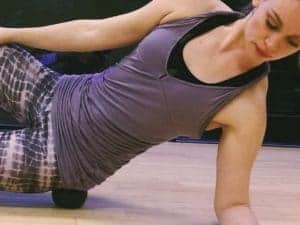A set of body rolling balls arrived on our doorstep and my husband freaked out. At the gym he has rolled a lacrosse ball across his back and shoulders to loosen the muscles. So, the prospect of fixing the “issues in his tissues” with a new type of rolling sphere was super appealing. A lot of people feel the same way. Body rolling is becoming increasingly popular in gyms and studios across the country. But what exactly is it?
Body rolling was first popularized in 1979 by a yoga teacher and bodyworker in Manhattan who was interested in healing herself after a hip injury. She believed that we are all walking around with a lot of muscle imbalance from chronic stress and old injuries (think laptop hunch, driving slouch, clenched back, etc.). By rolling out the muscles and tissues with a ball, a person could use knowledge of one’s own injuries and aches to reprogram stuck, unhealthy patterns in the body and restore a sense of balance.
The idea is to let the flesh, muscle, and tendon sink around the ball, and then work into tight, crunchy knots and muscle fibers. This allows for the fascia—the thin sheath of fibrous tissue around the muscles and organs—to loosen and reshape. Sound good? There’s more!
Since the balls are three dimensional, they can target areas that are hard to reach with traditional stretching and foam rolling. The balls massage the tendons, ligaments, bones, and even organs and the nervous system, stimulating blood flow. Pressing the ball into the abdomen and ribs, for example, can affect the large and small intestine, promoting healthy digestion. On top of that, the balls work in and around joints and vertebrae, creating space where there is unhealthy compression.
Sytera Field, who started teaching yoga body rolling nine years ago, considers herself a guide. Students have the control over the pressure and intensity of the practice, which is important because there are going to be mental and physical challenges. “You are asking your body to do something different and there is a conflict there,” she says. “There’s a resistance, and you have to decide if you are ready to let go of it. You have to be quiet enough in your mind to decipher the messages that you are getting and whether the sensations are productive or unproductive.”
Sytera studied Thai Yoga Massage in her hometown of Austin. She views body rolling as a form of giving oneself a Thai Yoga Massage. Body rolling is incredibly therapeutic because you get the benefits of stretching and massage at the same time.
Nici Bush, a SyteraYoga student who travels internationally for her job, body rolls regularly. She tosses a set of balls in her suitcase, and after flights she rolls the balls down her back, over her hamstrings, and into the constrictions in her neck and shoulders. After that, it’s easier to get into her yoga practice, and there is a better connection to the floor in standing poses. There are mental benefits, too. She says she gets that same floating feeling that you experience after receiving a professional massage.
At my house, I broke open the package of yoga balls and started rolling. Things started to shift. When I stood up, my legs weren’t tight in the same areas and I felt lighter. My shoulders moved back and there was more room for my belly to rise and fall with my breath.
My husband was going to try next, but then the puppy got to them. Did I mention that the balls are rubbery? We will be ordering a new set. For now, my husband has to wait.
Meghan Mullan is a freelance writer and SyteraYoga student.


Yes! Yes! Yes!